PRESENT DALAI LAMA
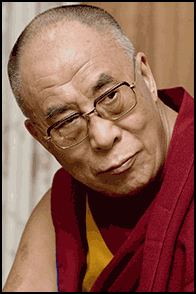 The present 14th Dalai Lama is the spiritual leader of Tibetan Buddhism and the head of the government-in-exile of Tibet. He is revered as a living god by his people and his followers and condemned as a feudal, splittist devil by the Chinese. Soft-spoken and chubby, he lives in India, unable to even pay visits to his homeland, and spends his time traveling the world to gain support for the Tibetan cause and seeking a non-violent solution to Tibet’s problems.
The present 14th Dalai Lama is the spiritual leader of Tibetan Buddhism and the head of the government-in-exile of Tibet. He is revered as a living god by his people and his followers and condemned as a feudal, splittist devil by the Chinese. Soft-spoken and chubby, he lives in India, unable to even pay visits to his homeland, and spends his time traveling the world to gain support for the Tibetan cause and seeking a non-violent solution to Tibet’s problems.
The Dalai Lama was the most widely respected world leader in a survey conducted by the International Herald Tribune in 2008 in the United States and five European countries. Michael Powell wrote in the New York Times, “The Dalai Lama has traveled restlessly and spoken passionately about Tibet, “The fruits of his labors are many: The world is spotted with Tibetan centers, and prayer flags flap from Delhi to London to Zurich to Todt Hill in Staten Island. Tibetan culture is celebrated in Hollywood and in popular art.”
The Dalai Lama is the exiled spiritual leader of Tibet and before his retirement in 2011 was the political leader of Tibetan exile community. He is known as His Holiness to Tibetan Buddhists and HHDL to his Twitter followers. "The Dalai Lama is the world's greatest living example of nonviolence and compassion, accessible to followers of all faiths," The Columbia University Buddhist scholar Robert Thurman wrote in Time. "He refuses to convert anybody to Buddhism and preaches tolerance. He continues the lineage of spiritual activist descending from Mohandas Gandhi and Martin Luther King." Even the Chinese acknowledge that “virtually all Tibetans have the Dalai in their hearts.”
“Officially, the Dalai Lama is the senior religious leader of Tibetan Buddhism, though most of his admirers know him from other pursuits. He has lent his name to at least a hundred books, on subjects ranging from ethics to the interaction between science and religion, and, more recently, "Business, Buddhism, and Happiness in an Interconnected World." (Some of these he wrote; many are edited collections of his speeches.) He is the unlikeliest avatar of the global age: a reincarnate lama who didn't set foot in the West until he was nearly forty and, to this day, holds no passport. (He travels on the yellow document of a refugee.) He has evolved from an oddity to a sage and a reluctant icon of endurance. [Source: Evan Osnos, The New Yorker, October 4, 2010]
See Separate Articles: DALAI LAMAS, THEIR HISTORY AND CHOOSING NEW ONES factsanddetails.com; DALAI LAMA LEADS TIBET AND ESCAPES TO INDIA factsanddetails.com; DALAI LAMA'S DAILY LIFE. ACTIVITIES AND VIEWS factsanddetails.com; DALAI LAMA'S CELEBRITY AND HOLLYWOOD FRIENDS factsanddetails.com; DALAI LAMA, POLITICS AND INTERNATIONAL RELATIONS factsanddetails.com; DALAI LAMA AND CHINA factsanddetails.com; AFTER THE DALAI LAMA DIES AND CHOOSING A NEW DALAI LAMA factsanddetails.com
RECOMMENDED BOOKS: “Freedom in Exile: The Autobiography of The Dalai Lama” by Dalai Lama Amazon.com; “The Dalai Lama: An Extraordinary Life” by Alexander Norman Amazon.com; “Kundun” by Mary Craig (book about the Dalai Lama's family) Amazon.com; “The Story of Tibet: Conversations with the Dalai Lama” by Thomas Laird Amazon.com; “Why the Dalai Lama Matters: His Act of Truth as the Solution for China, Tibet, and the World” by Robert Thurman Amazon.com; “The Life of My Teacher: A Biography of Kyabjé Ling Rinpoché” by His Holiness the Dalai Lama, Gavin Kilty, et al Amazon.com; “How to See Yourself as You Really Are” by Jeffrey Hopkins PhD, His Holiness the Dalai Lama, et al. Amazon.com; “The Art of Happiness” by His Holiness the Dalai Lama, Howard C. Cutler MD, et al. Amazon.com; “The Book of Joy: Lasting Happiness in a Changing World” by His Holiness the Dalai Lama and Desmond Tutu Amazon.com; Dalai Lamas: “Secret Lives of the Dalai Lama: The Untold Story of the Holy Men Who Shaped Tibet, from Pre-history to the Present Day” by Alexander Norman (Author), Dalai Lama Amazon.com; “The Fourteen Dalai Lamas: A Sacred Legacy of Reincarnation” by Glenn H. Mullin , Valerie Shepherd, et al. Amazon.com; “The Dalai Lama and the Emperor of China: A Political History of the Tibetan Institution of Reincarnation” by Peter Schwieger Amazon.com; “The Illusive Play: The Autobiography of the Fifth Dalai Lama” by Samten Gyaltsen Karmay Amazon.com; “Path of the Bodhisattva Warrior: The Life and Teachings of the Thirteenth Dalai Lama” by Glenn H. Mullin Amazon.com; “The Hidden Life of the Sixth Dalai Lama” by Simon Wickham-Smith Amazon.com
Dalai Lama Adulation and Myth
Ian Johnson wrote in the New York Review of Books: In the West “the Dalai Lama, enjoys a popular image as an irreproachable man of peace. But this overlooks the fact that the Dalai Lama began adult life as a theocrat leading a government with an army; only later did he transform himself into a Gandhi-influenced proponent of nonviolence who was awarded a Nobel Peace Prize. That transformation makes strategic sense, perhaps, for Tibetans in their struggle against an overwhelmingly powerful Chinese state, but it is a recent development for most of Tibet’s history, Buddhism has served the state. [Source: Ian Johnson, New York Review of Books, July 13, 2019]
The Dalai Lama has received the kind of acclaim and adulation associated more with rock stars than religious leaders. In September 2003, over 65,000 people came to see him sit on stage and offer self-deprecating wisdom in English at New York’s Central Park. Among religious leaders, only the Pope and Bill Graham have drawn more people. When he showed up in Vancouver in 2004, tickets for his stadium speech sold out within twenty minutes, a spectacle that seemed to his biographer Pico Iyer as if "a president was visiting, in the company of Mick Jagger."
Evan Osnos wrote in The New Yorker: “The Fourteenth Dalai Lama — Jetsun Jamphel Ngawang Losang Yeshe Tenzin Gyatso, known to many Tibetans as "the Presence" — has a biography so ripe for mythmaking that Hollywood has sought to capture it on film several times — once directed by Martin Scorsese and once starring Brad Pitt. Despite his oft-stated intention to abandon political life ("Retirement is also my human right"), the Dalai Lama has served longer than Queen Elizabeth, Fidel Castro, and other durable leaders, having taken the throne at the age of five, notwithstanding the fact that, for most of that time, he has not had much to rule.” [Source: Evan Osnos, The New Yorker, October 4, 2010]
Websites and Sources: Official Dalai Lama site dalailama.com ; Early Dalai Lamas minnesota.publicradio.org ; Dharamsala (Home of Dalai Lama ) site mcllo.com ; Wikipedia article Wikipedia ; Dalai Lama Quotes brainyquote.com ; Dalai Lama Foundation dalailamafoundation.org ; Nobel Prize Biography /nobelprize.org ; Tibet: Central Tibetan Administration (Tibetan government in Exile) www.tibet.com ; Chinese Government Tibet website eng.tibet.cn/; Wikipedia article on Tibet Wikipedia ; Wikipedia article on Tibetan History Wikipedia ; Tibetan News site phayul.com ; Books on the Dalai Lama: “The Open Road: The Global Journey of the Fourteenth Dalai Lama” by Pico Iyer (Knopf, 2008); “Kundun” by May Craig. The Dalai Lama’s autobiography is called “Freedom in Exile”. Film: “Unwinking Gaze”, a film about the Dalai Lama by Joshua Dugdale. Books by the Dalai Lama “Ethics for the New Millennium” by the Dalai Lama; “Freedom in Exile” by the Dalai Lama; “The Universe in a Single Atom” by the Dalai Lama; “The Wisdom of Forgiveness” by the Dalai Lama and Victor Chan
See Separate Articles DALAI LAMAS DALAI LAMA’s CURRENT LIFE Factsanddetails.com/China ; DALAI LAMA AND POLITICS Factsanddetails.com/China
Early Life of Dalai Lama
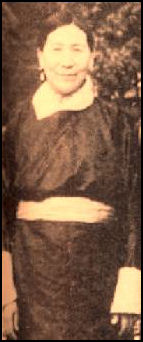
Dalai Lama's mother
The present and 14th Dalai Lama was born on July 6, 1935 in born in a mud and stone hut in the 20-family village known in Tibetan as Taktser ("Roaring Tiger"). Known in Chinese as Hongyacun, it is an hour by car today from Xining, the provincial capital of Qinghai, a remote and desolate region in western China formally known as Amdo region. The village is comprised of households clustered on a red-rock hill that villagers say resembles a crouching lion. His parents gave him the name Lhamo Dondrup (which means "Wish-fulfilling Goddess"). In his autobiography the Dalai Lama wrote: “my family was one of twenty or so making a living from the land there.”
Lhamo Dondrup was the ninth child and second son of peasant-farmers, Choekyong and Dekyi Tsering. He was born on the floor of a cow shed on his family’s farm. As a child he dressed in traditional Tibetan clothes and he spent the early years of his life in a square mud walled house without windows. His parents met for the first time at their wedding ceremony. They had 16 children but only seven survived past infancy.
Dalai Lama’s Family
The current Dalai Lama was born to a family of farmers in northeastern Tibet. His mother bore sixteen children, seven of whom survived. His father was a horseman with a short temper. The family was not rich, but it was well established: the boy's elder brother and great-uncle had been recognized as high-ranking lamas.
In 1957, the Dalai Lama's two brothers, who were in exile by then, put the CIA in touch with Tibetan insurgents and helped lauch the CIA’s secret war in Tibet in the 1960s. When the conflicted fizzled out in the mid 1970s one of the Dalai Lama’s brothers settled in Bloomington; another moved to Hong Kong; a third went to New Jersey, where, at one point, he worked as a school custodian known as Sam.
The Dalai Lama’s older brother Takster Rinpoche (Thubten Jigme Norbu) was recognized at the age of 3 as the reincarnated abbot of Kumbum monastery — one of the most important monasteries in Tibetan Buddhism — in Qinghai Province. He was active in the pro-independence movement and lived for more than forty years in Bloomington, Indiana, teaching Tibetan language and history at Indiana University in the United States. He died at the age of 86 in 2008.
Search for the Present Dalai Lama
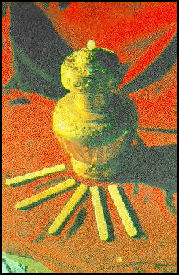
Golden urn
After the 13th Dalai Lama died on December 17, 1933, his body was found facing east. Monks later repositioned the head, which reputedly moved on its own to face northwest. There were also reports of rainbows arching across sky in the same direction. After the Tibetan oracle also faced northwest when he put on a mask and went into a trance, parties of monks organized to search for the reincarnation of the Dalai Lama headed northwest.
Michael Powell wrote in the New York Times, “The search for the present Dalai Lama commenced in earnest in 1935 when the embalmed head of his deceased predecessor is said to have wheeled around and pointed toward northeastern Tibet. the story goes, a giant, star-shaped fungus grew overnight on the east side of the tomb. An auspicious cloud bank formed and a regent saw a vision of letters floating in a mystical lake, one of which — Ah — he took to refer to the northeast province of Amdo [Qinghai Province].”[Source: Michael Powell, New York Times, January 31, 2009]
The search parties looked for house near a three-story monastery with a turquoise and gold roof that a senior Lama saw in a dream. The monks found three children who fulfilled some of the requirements necessary to become the Dalai Lama. In Taktser, the village of one of the children, the arrival of the lamas had been preceded by several strange omens, including the arrival of many crows where crows had never been seen before. This was the village of two-year-old Lhamo Dondrup.
The Dalai Lama wrote in a 1990 memoir, "Freedom in Exile," the corpse of the previous Dalai Lama had turned its embalmed head to face northeastern Tibet; a senior monk peered into the waters of a sacred lake and saw letters that suggested "Amdo," the region in the northeast, as well as an image of the toddler's family house. When the party reached the home, they monitored the boy for days and then tested him by laying out prayer beads, drums, and other objects and asking him to identify which ones had belonged to the previous Dalai Lama.
Members of the search party arrived in Taktser disguised as traders. The group leader was dressed as a servant but was wearing a rosary that belonged to the 13th Dalai Lama. Two-year-old Lhamo Dhondrub asked for the rosary and was told he could have it if he guessed who he was talking to. The boy correctly said the leader dressed as a servant was ‘sera aga? — lama from Sera monastery. The boy also impressed the visitors by knowing other details about them.
The senior monk spent the evening observing the child, playing with him and giving him some tests. The young boy passed all the tests: he correctly other things that belonged to the 13th Dalai Lama and he answered "the questions" correctly. He also had all the physical features that the Dalai Lama was supposed to have: large ear lobes, sad eyes, "tiger stripes" on his legs, and four or more of the eight important bodily marks.
Enthronement of the 14th Dalai Lama
 According to the Chinese, on December 12, 1938 a local Tibetan official reported to the Chairman of the Commission for Mongolian and Tibetan Affairs of the Nationalist Government that three soul boys had been selected. On January 26, 1940, the Tibetan official sent a letter to the central government reporting that the clerical and lay populace of Tibet had chosen the soul boy Lhamo Dondrop to be the genuine reincarnation of the Thirteenth Dalai Lama.
According to the Chinese, on December 12, 1938 a local Tibetan official reported to the Chairman of the Commission for Mongolian and Tibetan Affairs of the Nationalist Government that three soul boys had been selected. On January 26, 1940, the Tibetan official sent a letter to the central government reporting that the clerical and lay populace of Tibet had chosen the soul boy Lhamo Dondrop to be the genuine reincarnation of the Thirteenth Dalai Lama.
When Lhamo Dhondrub was recognized as a reincarnated Dalai Lama he was renamed Jetsun Jamphel Ngawang Lobsang Yeshe Tenzin Gyatsi (meaning "Holy Lord, Gentle Glory, Compassionate, Defender of the Faith, Ocean of Wisdom"). Those around him sometimes call him Yeshe Norbu (the "Wish-fulfilling Gem”).
After being selected as a soul boy at the age of three, Lhamo Dondrup was brought to Taer Monetary near Xining, Qinghai Province, on a sacred white yak, escorted by three lamas sent from Lhasa to find him. After spending some time in Taer Monastery he was brought to Lhasa, where he was "hidden away like an owl," as he put it. Apart from tutors, and occasional visits with his family, his closest contacts were the sweepers who maintained the grounds, and whenever he was called to preside over long, elaborate ceremonies he worried, most of all, about whether his bladder would hold out. He was installed as the leader of 6 million Tibetan Buddhists in a ceremony at Potala Palace at the age of six.
On January 31, 1940, Chinese president Chiang Kai-shek authorized expenses for enthronement and sent a document that read "the Thirteenth Dalai Lama shall be enthroned as the Fourteenth Dalai Lama." On February 22, 1940, the enthronement ceremony for the four-year-old Dalai Lama was held at Potala Palace.
Dalai Lama's Training
After his enthronement, the Dalai Lama lived and underwent rigorous training at Norbulingka summer palace. He studied Tibetan art and culture, Sanskrit, medicine, and Buddhist philosophy, metaphysics, epistemology and logic. At the age of 24, he was awarded a Geshe Lharampa degree (doctorate in Buddhist philosophy).
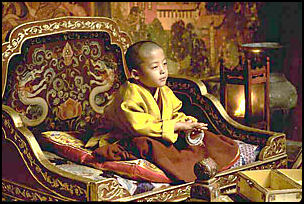
Scene from the film Kundun
During his training, the Dalai Lama lived in seclusion, slept on hard, woolen cushions, had no playmates, ate his meals alone, spent most of time meditating, praying or studying and associated mostly with old men. When he had he free time he liked to fix machines, shoot at his toys with an air rifle and take apart watches, a music box, and other devices. He spent so much time looking at the night sky through a telescope that he concluded, contrary to Tibetan beliefs, that the moon was not lit up from within.
As a child he had the run of Potala Palace. He learned calligraphy by copying his predecessors’ will.
When he as four he received envoys from U.S. President Franklin Roosevelt. When he was seven he was asked if Tibet could be used as part of transportation network to bring supplies to China during World War II. In 1942, U.S. President Franklin Roosevelt sent the Dalai Lama a gold Rolex watch with a letter as a gesture to seek relations with Tibet. The monk often tells the story of the watch saying it helped spur his lifelong interest in science. “At the that time, my only interest is the gift of the watch, not the letter,” he said during a visit to Washington in 2010 when he was given a copy of the Roosevelt letter by U.S. President Barack Obama. The Dalai lama had the watch in his pocket when he was presented the Congressional Gold medal in 2007 by U.S. President George W. Bush.
The Dalai Lama’s education lasted almost two decades and included instruction in Buddhist metaphysics, Tibetan art and culture, logic, Sanskrit, and traditional medicine. He secured a “geshe” degree, a Buddhist equivalent of a Ph.D.
On his time at Norbulingka palace, the Dalai Lama wrote, "It was very pleasant there, and I was very happy. I remember everything was fresh, calm and peaceful. There were lots of flowers."
Heinrich Harrer and the Dalai Lama
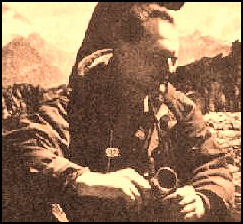
Heinrich Harrer, a selfish Austrian mountain-climber with connections to the Nazi party, befriended the Dalai Lama and became his tutor. Featured in the film “Seven Years in Tibet”, the friendship began when Harrer was 37 and the Dalai Lama was 14. Harrer taught the Dalai Lama English and geography, informed him about Western customs, and explained the best he could how planes flew, tanks worked and atom bombs were detonated. Harrer and the Dalai Lama shared the same birthday, July 6.
Describing the first time he saw the Dalai Lama in a procession, Harrer wrote: "And now approached the yellow, silk-lined palanquin of the Living Buddha, gleaming like gold in the sunlight. The bearers were six-and-thirty men in green silk coats, wearing red plate-shaped caps. A monk was holding a huge iridescent sunshade made of peacock's feathers over the palanquin. The whole scene was a feast for the eyes — a picture revived from a long-forgotten fairy tale of the Orient." Anything the Dalai Lama touched, Harrer said, was seized as an auspicious object.
Explaining how he met Harrer, the Dalai Lama said, "We had an old movie projector and a generator which always broke down. My aides were afraid I'd be electrocuted." Harrer was called in. "In those days, we considered all Westerners to be experts in mechanical things...During his stay in Tibet, everyone liked him." To amuse himself the Dalai Lama used to take projector completely apart and put it back together.
Image Sources: Dalai Lama com, Purdue University, Cosmic Harmony
Text Sources: New York Times, Washington Post, Los Angeles Times, Times of London, National Geographic, The New Yorker, Time, Newsweek, Reuters, AP, Lonely Planet Guides, Compton’s Encyclopedia and various books and other publications.
Last updated September 2022
